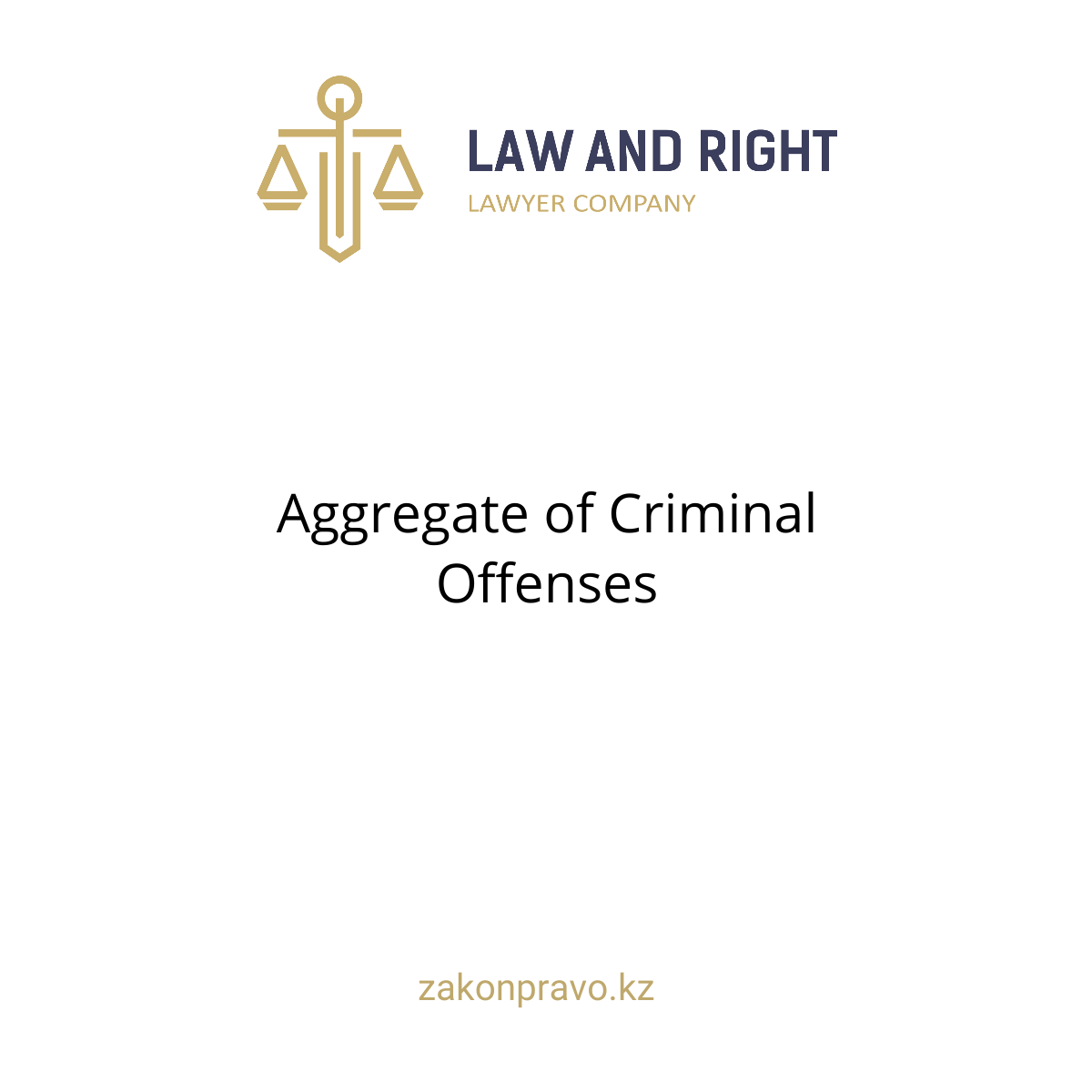Aggregate of Criminal Offenses
According to Article 13 of the Criminal Code of the Republic of Kazakhstan (CC RK), an aggregate of criminal offenses is defined as the commission of two or more acts covered by different articles or parts of articles of the CC RK, provided that the person has not yet been convicted or released from criminal liability for them. Let's review the provisions of this article with explanations, examples from judicial practice, and references to other regulatory acts.
1. Aggregate of Criminal Offenses as a Form of Multiple Crimes
Multiplicity of crimes is classified into:
Repetition (Article 12 CC RK) – committing several crimes under the same article (or part of an article).
Aggregate of crimes (Article 13 CC RK) – committing crimes under different articles or parts of articles.
Recidivism (Article 14 CC RK) – committing a new crime after being convicted for a previous one.
📌 Example 1: If a person commits theft (Article 188 CC RK) and then inflicts serious bodily harm on the victim (Article 106 CC RK), these crimes are qualified as an aggregate since they are covered by different articles.
📌 Judicial Practice: According to the Summary of Judicial Practice by the Supreme Court of the Republic of Kazakhstan dated June 25, 2021, No. 4, in cases involving theft and fraud, courts are obliged to impose punishments separately for each offense and then apply the rules of full or partial aggregation of punishments.
2. Types of Crime Aggregates
Part 1 of Article 13 CC RK: Aggregate of Heterogeneous CrimesIf a person commits several crimes provided for by different articles or parts of articles and has not yet been convicted for them, they bear responsibility for each offense separately.
📌 Example 2: A person first commits fraud (Article 190 CC RK), then forges documents (Article 385 CC RK). In this case, both articles are applied.
📌 Judicial Practice: In case No. 1-601/2022, the Supreme Court of Kazakhstan noted that if the accused forged documents as part of a fraudulent scheme, but these actions fall entirely under Article 190 CC RK, only the special rule (Article 190 CC RK) is applied.
Part 2 of Article 13 CC RK: Ideal Aggregate of CrimesWhen a single act (or omission) contains elements of two or more crimes, an ideal aggregate applies.
📌 Example 3: A person threatens to kill (Article 115 CC RK) and simultaneously causes moderate bodily harm (Article 107 CC RK). In this case, one act qualifies under two articles.
📌 Regulatory Guidance: The Supreme Court of Kazakhstan, in its Normative Resolution No. 1 dated May 11, 2007, clarified that when two crimes arise from one act, the court must separately justify the application of each article.
3. Relationship Between Aggregation and Competition of Legal Norms
Part 3 of Article 13 CC RK addresses the competition between general and special legal norms. If a special rule fully covers the act, only that rule is applied.
📌 Example 4:A driver hits a pedestrian and flees the scene. If the escape is considered a separate crime (Article 347 CC RK), this is an aggregate.However, if the accident resulted in death (Article 345, Part 3 CC RK), the escape is covered by this article, and Article 347 CC RK does not apply.
📌 Judicial Practice: The Supreme Court clarified that if one crime fully covers another (e.g., illegal possession of weapons – Article 287 CC RK and illegal manufacture of weapons – Article 288 CC RK), only the stricter norm is applied.
4. Sentencing in Cases of Crime Aggregation
According to Article 58 CC RK, punishment for an aggregate of crimes is assigned by:
Full aggregation of sentences – if the crimes are unrelated.
Partial aggregation of sentences – if the crimes are related.
📌 Judicial Practice: In case No. 2-405/2023, the defendant committed two crimes: theft (Article 188 CC RK) and document forgery (Article 385 CC RK). The court imposed a sentence of 3 years of imprisonment for theft and 2 years for document forgery. Using partial aggregation, the final sentence was set at 4 years of imprisonment.
5. Differentiating Between Aggregation and Repetition
| Criterion | Repetition (Article 12 CC RK) | Aggregation (Article 13 CC RK) |
|---|---|---|
| Number of crimes | Two or more under one article | Two or more under different articles |
| Previous conviction | No, if already sentenced | No, if not yet convicted |
| Example | Two thefts (Article 188 CC RK) | Theft (Article 188) + Fraud (Article 190) |
📌 Important Clarification: In Normative Resolution No. 7 dated June 28, 2019, the Supreme Court of Kazakhstan clarified that if the accused committed crimes under different articles but within the framework of a single criminal episode, this constitutes an ideal aggregate.
6. Conclusions and Practical Significance
🔹 The aggregation of crimes means that a person has committed two or more crimes for which they have not yet been convicted.🔹 There are two types of aggregation: real (separate offenses) and ideal (one act falling under multiple articles).🔹 If one crime fully covers another, only the special rule applies.🔹 When assigning punishment, Article 58 CC RK provides for combining sentences either fully or partially.
📌 Practical Significance: Courts must correctly differentiate between aggregation and repetition of crimes, and also properly apply the rules of legal norm competition. Errors in legal qualification may result in incorrect sentencing or violation of the defendant’s rights.
Attention!
Law and Law Law Law draws your attention to the fact that this document is basic and does not always meet the requirements of a particular situation. Our lawyers are ready to assist you in legal advice, drawing up any legal document suitable for your situation.
For more information, please contact a Lawyer / Attorney by phone: +7 (708) 971-78-58; +7 (700) 978 5755, +7 (700) 978 5085.
Attorney at Law Almaty Lawyer Legal Services Legal Advice Civil Criminal Administrative Cases Disputes Protection Arbitration Law Firm Kazakhstan Law Office Court Cases


